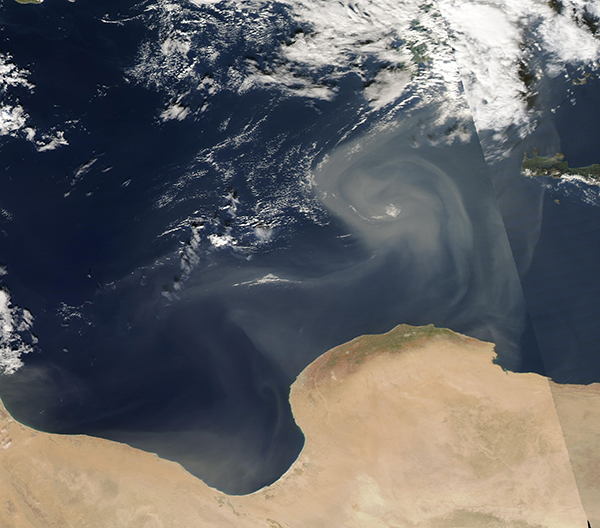Images
November 20, 2022 - Dust Swirling over the Mediterranean
Tweet
Gusting winds carried Saharan dust over the Mediterranean Sea in mid-November 2022.
On November 17, the Moderate Resolution Imaging Spectroradiometer (MODIS) on board NASA’s Terra satellite acquired a true-color image of the start of a dust storm, with camel-colored sand and dust blown into a swirling pattern between Libya (south) and Greece. Subsequent MODIS images show that clouds of dust have continued to pulse over northern Libya and the Mediterranean through November 19. While the exact source of the dust isn’t clear, it appears to primarily rise from sand seas in northern Libya.
Libya, a country about two-and-a-half times the size of the U.S. state of Texas, is one of the driest countries in the world. According to the United Nations Office for Coordination of Human Affairs, as of 2021, the country is more than ninety-five percent desert, with most of the land barren with flat to undulating plains. Only about one percent of the land is arable, and the country is forced to import about 75 percent of the food needed to meet local needs. OCHA notes that the Great Man-Made River project, which provides 60 per cent of all fresh water used in Libya, draws water from non-renewable aquifers that cannot be recharged by rain. The country is susceptible to floods, sandstorms, dust storm and desertification. The UN notes that Libya is a country living in “fragile circumstances” and it is one of the areas severely vulnerable to the effects of climate change.
Image Facts
Satellite:
Aqua
Date Acquired: 11/7/2022
Resolutions:
1km (629.1 KB), 500m (1.5 MB), 250m (863 KB)
Bands Used: 1,4,3
Image Credit:
MODIS Land Rapid Response Team, NASA GSFC
Tweet
Gusting winds carried Saharan dust over the Mediterranean Sea in mid-November 2022.
On November 17, the Moderate Resolution Imaging Spectroradiometer (MODIS) on board NASA’s Terra satellite acquired a true-color image of the start of a dust storm, with camel-colored sand and dust blown into a swirling pattern between Libya (south) and Greece. Subsequent MODIS images show that clouds of dust have continued to pulse over northern Libya and the Mediterranean through November 19. While the exact source of the dust isn’t clear, it appears to primarily rise from sand seas in northern Libya.
Libya, a country about two-and-a-half times the size of the U.S. state of Texas, is one of the driest countries in the world. According to the United Nations Office for Coordination of Human Affairs, as of 2021, the country is more than ninety-five percent desert, with most of the land barren with flat to undulating plains. Only about one percent of the land is arable, and the country is forced to import about 75 percent of the food needed to meet local needs. OCHA notes that the Great Man-Made River project, which provides 60 per cent of all fresh water used in Libya, draws water from non-renewable aquifers that cannot be recharged by rain. The country is susceptible to floods, sandstorms, dust storm and desertification. The UN notes that Libya is a country living in “fragile circumstances” and it is one of the areas severely vulnerable to the effects of climate change.
Image Facts
Satellite:
Aqua
Date Acquired: 11/7/2022
Resolutions:
1km (629.1 KB), 500m (1.5 MB), 250m (863 KB)
Bands Used: 1,4,3
Image Credit:
MODIS Land Rapid Response Team, NASA GSFC




